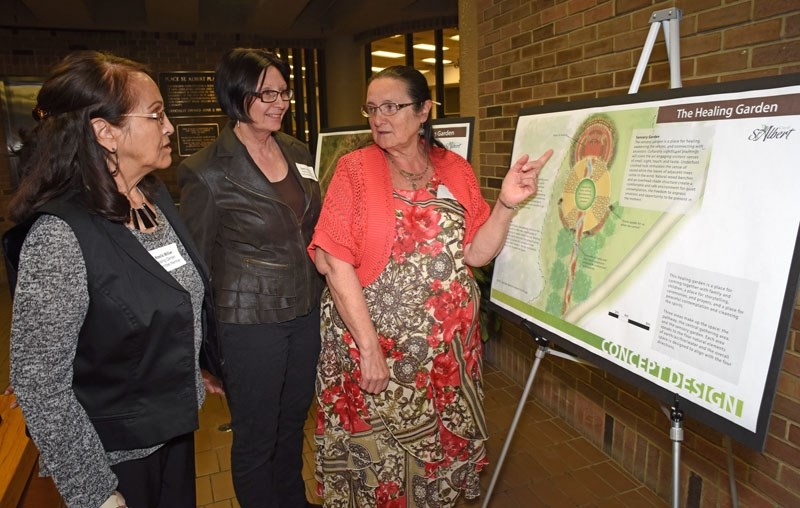Noella Willier didn't have a name when she was growing up. She had a number.
"I was taken away from my parents at the age of six," said the 70-year-old member of the Sucker Creek First Nation near Lesser Slave Lake, and forced to attend a residential school.
"We didn't have the option of going home."
There, students were stripped of their names, forced to stand naked in front of everyone while being beaten with a big white strap, and fed terrible food.
"They would cook the entire fish ... scales and everything, and mush it up," she recalled.
"That was what we would eat on Good Friday."
Willier was one of about 25 dignitaries at St. Albert Place for an open house on the city's healing garden project. She's also on the project's advisory committee.
Set for construction this summer, the $169,000 project is meant recognize the history of residential schools in St. Albert and act as a symbolic first step toward Canada's reconciliation with its aboriginal people.
This will be a place for all those who are in pain, Willier said, not just aboriginals.
"It is a place (where you can) feel like you are not alone in your state of recovery."
The reconciliation project
The garden is the brainchild of Rev. James Ravenscroft of the St. Albert United Church and Maggie Hodgson, past CEO of the Nechi Institute and renowned residential school advocate, said Kelly Jerrott, cultural services director with the City of St. Albert. When finished, it will be located directly across from St. Albert Place and will be part of Founder's Walk.
Not many people know that St. Albert was once host to two residential schools, Ravenscroft said (the Youville school atop Mission Hill and the Edmonton Indian Residential School, now the home of Poundmaker's Lodge). The United Church ran the one at Poundmaker's.
"It's important for us to acknowledge that history and do what we can to bring healing and reconciliation between the indigenous and non-indigenous communities."
Hazel McKennitt, a residential school survivor and adviser on the garden project, said she was very happy to see the city walking alongside Canada's aboriginal peoples along the road to reconciliation with this project.
"We all have to learn to live together, and this is the next step on our journey."
The garden's preliminary design includes many symbolic aspects. A winding path connects it to the Sturgeon River, symbolizing water and the idea of going on a journey, Jerrott said. The garden also faces south to reflect the heat of the sun (fire) and features trees that will rustle in the wind.
The front part of the garden has a grassy knoll surrounded by a concrete seating area and large stones, she continued. This area is meant for ceremonies and symbolizes a connection with the earth.
The back part of the garden will feature benches and native plants significant to aboriginal culture such as sage and chokecherry. Partially enclosed by an overhang and trees, this area is meant for quiet reflection.
While there will be some interpretive signage about residential schools, Jerrott said most of the detailed displays will be elsewhere on Founders' Walk.
"The intent was that this be a positive place."
The city will continue to consult with residents on the park's design with the aim to have it open by this fall, Jerrott said.
Healing never takes place in isolation, Willier said. This garden will be a place where people in need of support from all nations will gather to share stories and find themselves.
"The people who are going to use this garden are going to be super-blessed."
Draft plans for the garden can be found at stalbert.ca/living-here/st-albertans-legacy/the-healing-garden.




